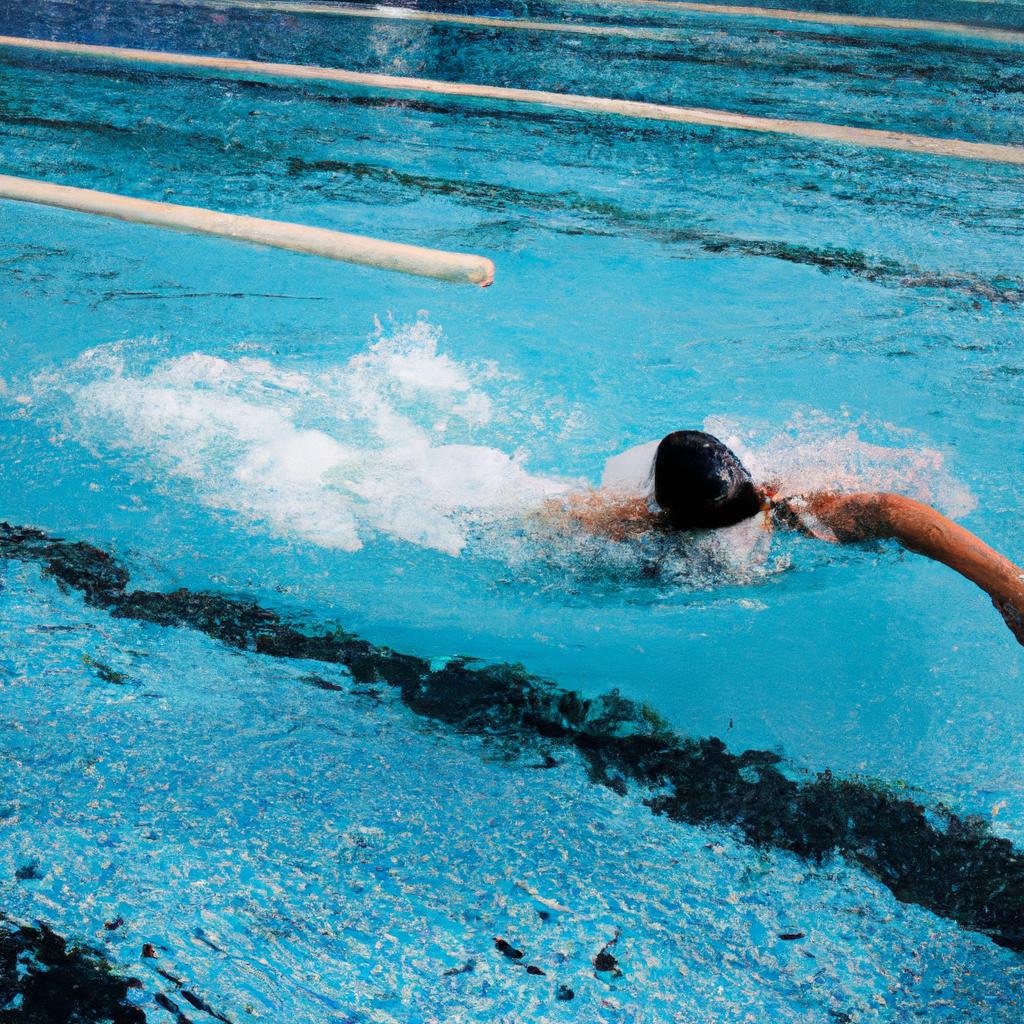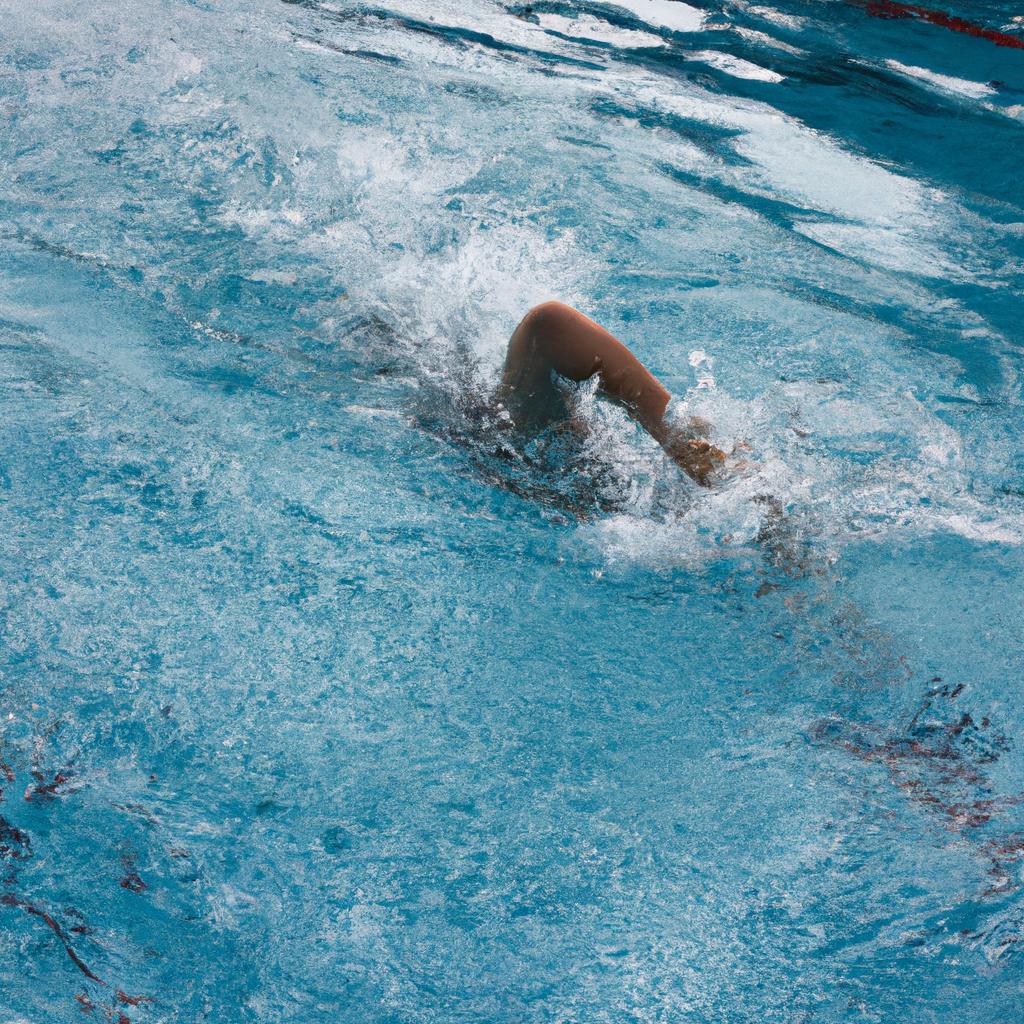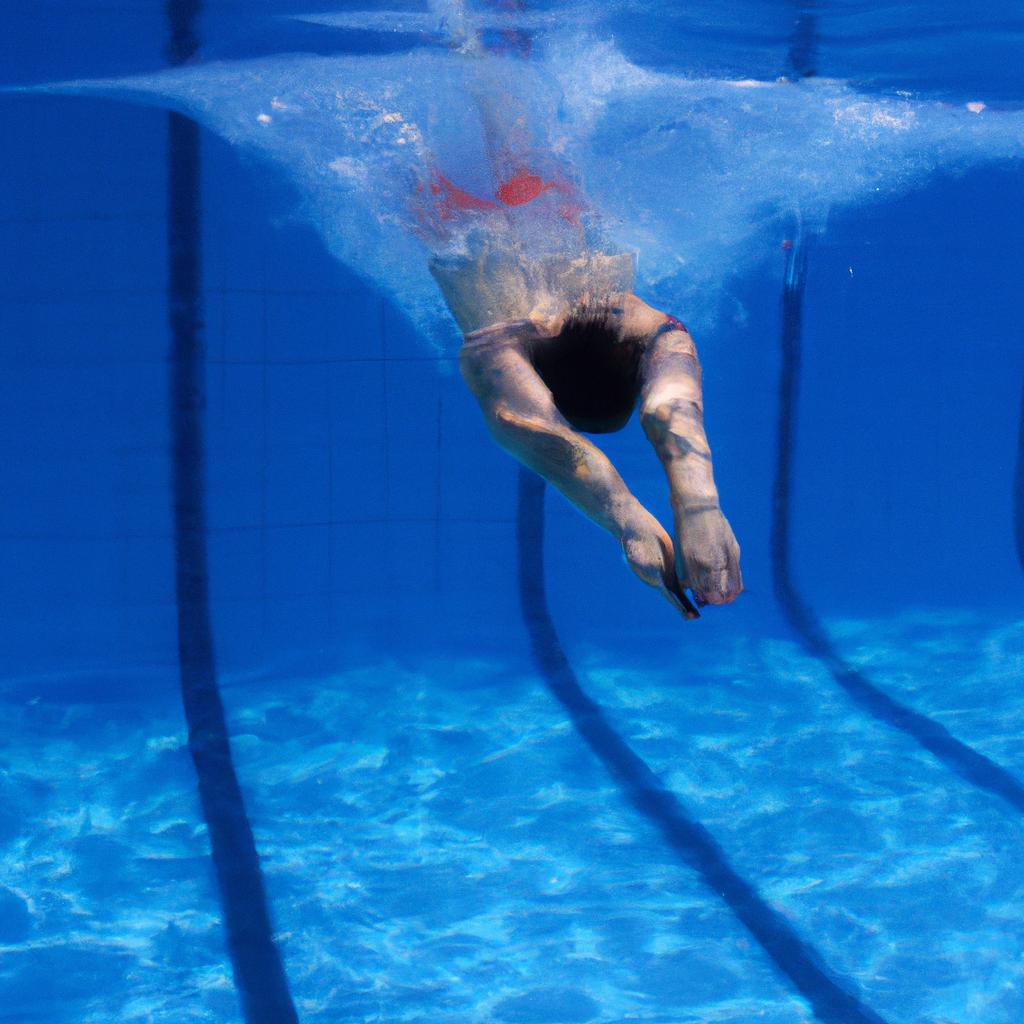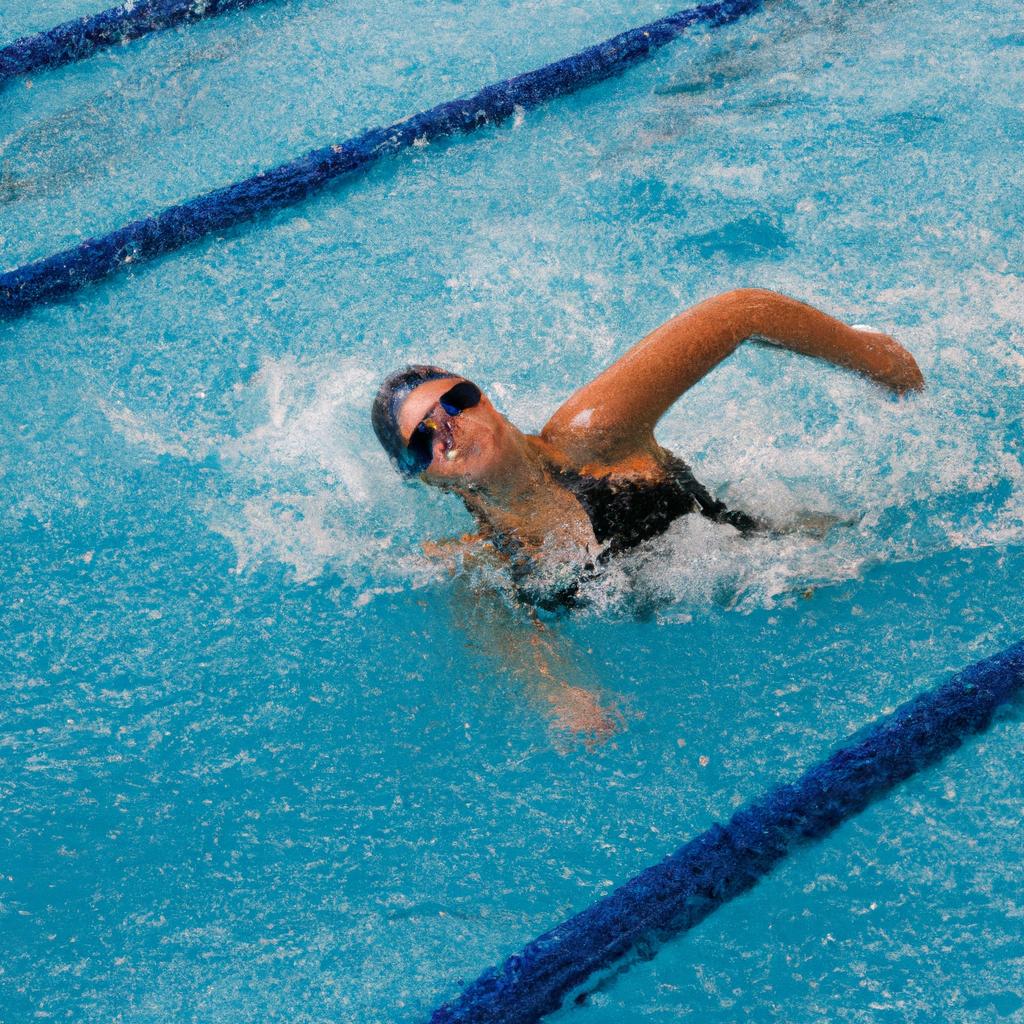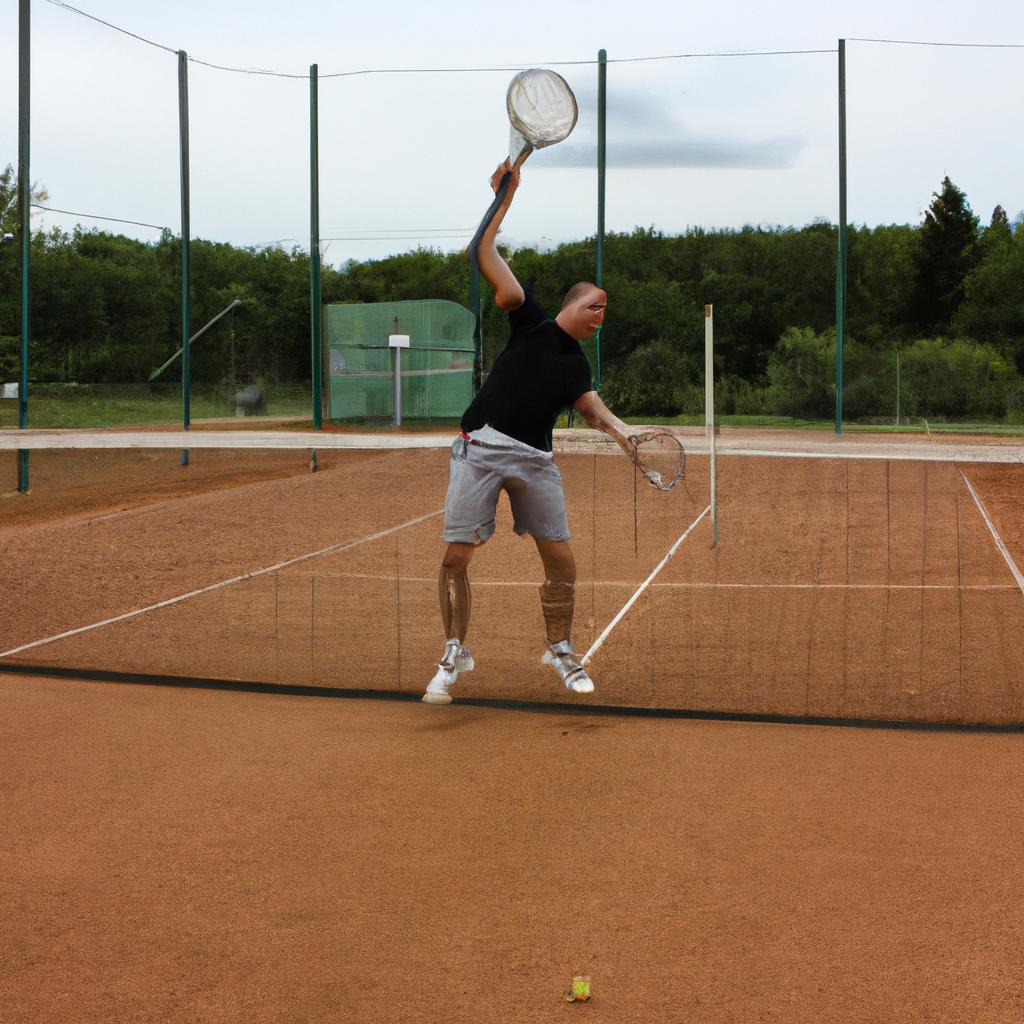The butterfly swimming stroke, also known as the “fly,” is a challenging and powerful technique that requires both strength and finesse. It has been widely embraced in various games and sports due to its unique characteristics and impressive performance outcomes. For instance, imagine a hypothetical scenario where an aspiring swimmer named Sarah aims to compete at the highest level of her sport. In order to achieve her goal, she must master the butterfly stroke, which will not only enhance her speed but also improve her overall swimming ability.
In recent years, there has been a growing interest among athletes, coaches, and researchers regarding the biomechanics and physiological demands of the butterfly stroke in games and sports. This stroke involves simultaneous movements of both arms lifting out of the water while executing dolphin-like undulating leg kicks. The complex nature of this technique necessitates meticulous attention to detail in terms of body positioning, timing, coordination, and muscular engagement. By mastering these intricate aspects, swimmers can maximize their efficiency in the water while minimizing energy expenditure.
To fully comprehend the significance of mastering the butterfly stroke in games and sports, it is crucial to explore the benefits it offers beyond mere aesthetics. This includes improved upper body strength development through enhanced core stability and increased shoulder mobility. Furthermore, by engaging the muscles in the arms, chest, and back, the butterfly stroke helps to build muscular endurance and power. This can greatly contribute to overall athletic performance, as a strong upper body is essential for many sports such as rowing, tennis, and gymnastics.
Additionally, mastering the butterfly stroke can enhance cardiovascular fitness by demanding high levels of oxygen consumption and improving lung capacity. The combination of powerful arm movements and undulating leg kicks requires swimmers to maintain a continuous flow of energy throughout their bodies, leading to increased cardiovascular efficiency over time.
Moreover, the butterfly stroke promotes overall body coordination and flexibility. The synchronized movement of the arms and legs requires precise timing and control, which can improve proprioception (awareness of one’s body position) and fine motor skills. This can benefit athletes across various sports that require agility, balance, and quick reaction times.
In conclusion, mastering the butterfly stroke in games and sports offers numerous benefits beyond its aesthetic appeal. It enhances upper body strength development, improves cardiovascular fitness, promotes body coordination, and increases flexibility. By diligently practicing this challenging swimming technique, athletes like Sarah can gain a competitive edge in their respective sports while enjoying the physical benefits it provides.
The Evolution of Butterfly Stroke in Competitive Swimming
Imagine a young swimmer named Emma, who dreams of becoming an Olympic champion. She spends hours training every day, perfecting her technique and striving for excellence in the pool. One stroke that has always fascinated her is the butterfly stroke – its gracefulness and power are unmatched. As she delves deeper into the history of competitive swimming, Emma discovers how this stroke has evolved over time to become one of the most challenging yet rewarding techniques in the sport.
Throughout the years, butterfly stroke has undergone significant changes, adapting to meet the demands of modern competitive swimming. Initially, it was known as the “dolphin crawl” and was introduced as a variation of breaststroke in the early 20th century. Swimmers would perform a simultaneous arm movement while kicking their legs together like a dolphin’s tail. However, this technique faced criticism due to its potential strain on swimmers’ backs and shoulders.
In response to these concerns, modifications were made to refine and improve the butterfly stroke. The leg movement changed from a simultaneous kick to an up-and-down motion called the “butterfly kick,” which reduced strain on swimmers’ bodies. Additionally, swimmers started bending both arms simultaneously above water before plunging them back into the water with forceful sweeps—thus creating a symmetrical and powerful rhythm characteristic of today’s butterfly stroke.
To fully grasp the significance of these developments, let us consider some emotional aspects associated with mastering butterfly stroke:
- Achievement: Mastering butterfly stroke requires immense dedication and perseverance.
- Elegance: When executed flawlessly, each movement flows seamlessly into another—a true display of elegance.
- Strength: The intense movements demand physical strength and stamina.
- Mental Toughness: Overcoming initial challenges fosters mental resilience among athletes.
| Emotion | Description |
|---|---|
| Excitement | The thrill of pushing one’s limits and achieving personal bests. |
| Determination | The unwavering commitment to practice relentlessly until mastery is attained. |
| Fulfillment | The sense of accomplishment derived from mastering such a complex stroke. |
As we delve further into the world of butterfly stroke, it becomes evident that this technique goes beyond physicality—it embodies the spirit of competition and the pursuit of excellence in swimming. In the subsequent section on “Key Techniques and Drills to Improve Butterfly Stroke,” we will explore specific strategies swimmers can employ to refine their form and enhance their performance in this demanding stroke.
Key Techniques and Drills to Improve Butterfly Stroke
As the butterfly stroke has evolved over time, it has become a powerful and elegant swimming technique that requires precise coordination and strength. One real-life example of its effectiveness can be seen in the case study of Olympic swimmer Michael Phelps. Phelps, known for his exceptional skills in various swimming strokes, particularly excelled in the butterfly stroke, which contributed significantly to his success as an athlete.
To master the butterfly stroke, swimmers must focus on key techniques and drills that enhance their performance. These techniques have been developed through years of research and observation by experts in the field. Incorporating these techniques into training sessions allows swimmers to improve their form and efficiency while reducing energy expenditure. Some essential aspects include:
- Proper body positioning: Maintaining a streamlined body position helps reduce resistance and enables efficient movement through the water.
- Rhythm and timing: The coordination between arm movements and leg kicks is crucial for achieving maximum propulsion during each stroke cycle.
- Breathing techniques: Learning how to breathe effectively without interrupting the flow of the stroke is fundamental in maintaining stamina throughout a race or practice session.
- Core strength development: Strengthening core muscles aids stability during the undulating motion characteristic of the butterfly stroke.
To further illustrate the significance of these techniques, we present a table showcasing four benefits associated with mastering the butterfly stroke:
| Benefits of Mastering Butterfly Stroke |
|---|
| Increased power |
| Improved endurance |
| Enhanced speed |
| Reduced risk of injury |
These benefits demonstrate not only physical advantages but also psychological rewards for those who commit to mastering this demanding swimming style. By incorporating proper technique and discipline into their training regimen, athletes can experience remarkable improvements both inside and outside the pool.
Considering all these factors, it becomes evident that perfecting one’s butterfly stroke yields numerous advantages. In subsequent sections, we will explore another fascinating aspect related to this versatile technique: its application in water polo. Understanding the fundamentals of butterfly stroke lays a strong foundation for excelling in this dynamic sport, where speed and agility play pivotal roles. So let us dive into the world of Butterfly Stroke: A Versatile Technique in Water Polo.
Butterfly Stroke: A Versatile Technique in Water Polo
Having explored the key techniques and drills to enhance one’s butterfly stroke, it is evident that mastering this technique can have profound implications across various aquatic sports. In particular, water polo players often utilize the butterfly stroke as a versatile technique during gameplay. By seamlessly integrating fluidity, power, and agility, athletes can effectively navigate through dynamic water environments while executing precise movements.
Section – Butterfly Stroke: A Versatile Technique in Water Polo
To illustrate the significance of the butterfly stroke in water polo, consider a hypothetical scenario involving two teams competing for victory. In this intense match-up, Team A strategically employs the butterfly stroke to swiftly maneuver past their opponents’ defensive line. With its unique combination of speed and strength, the butterfly stroke allows them to quickly close gaps between players and create scoring opportunities with precision passes or powerful shots at goal.
A variety of factors contribute to the effectiveness of the butterfly stroke in water polo:
-
Enhanced Speed and Endurance:
- The dolphin-like undulating movement of the body generates significant propulsion.
- Increased cardiovascular fitness enables sustained performance throughout matches.
- Quick bursts of acceleration allow players to outpace opponents when necessary.
-
Superior Maneuverability:
- The streamlined body position reduces resistance against water flow.
- Precise arm coordination facilitates quick changes in direction during fast-paced gameplay.
- Efficient leg kick aids swifter turns and agile navigation around opponents.
-
Improved Ball Handling Skills:
- Coordination between upper body movements and leg kicks enhances ball control abilities.
- Strong core engagement supports stability for accurate throws or catches under pressure.
-
Strategic Advantage:
- Utilizing the butterfly stroke in water polo surprises opponents and disrupts their defensive strategies.
- The ability to swiftly transition between offensive and defensive positions increases tactical flexibility.
In light of these advantages, it is evident that mastering the butterfly stroke can significantly impact an athlete’s performance in water polo. By effectively utilizing this versatile technique, players can elevate their skills and contribute to their team’s success on both ends of the pool.
Transition into subsequent section:
Understanding the versatility of the butterfly stroke extends beyond water polo, as its demanding nature also makes it a challenging stroke frequently encountered in triathlon swimming events.
Butterfly as a Challenging Stroke in Triathlon Swimming
Transitioning from the previous section discussing the versatility of the butterfly stroke in water polo, we now delve into its role as a challenging stroke in triathlon swimming. To illustrate this point, let us consider an example: imagine a dedicated triathlete named Sarah preparing for her upcoming race. As she trains rigorously to improve her performance, mastering the butterfly stroke becomes crucial for her success.
The butterfly stroke presents unique challenges that test both physical and mental endurance, making it an ideal choice for triathlon swimmers seeking to enhance their skills. Here are some key aspects that make the butterfly stroke particularly demanding:
-
Upper Body Strength: The butterfly requires significant upper body strength due to the simultaneous arm movement known as “pull” and “recovery.” Swimmers must generate enough power to propel themselves forward while maintaining proper technique throughout each stroke cycle.
-
Breathing Technique: Coordinating breath with the rhythm of the dolphin kick is essential in mastering the butterfly. Unlike other strokes where breathing occurs more freely, swimmers must learn how to take quick breaths during specific moments within each stroke cycle.
-
Timing and Coordination: Achieving perfect timing and coordination between arms, legs, and breathing can be incredibly challenging in the butterfly stroke. It demands precise execution of multiple movements simultaneously, requiring extensive practice to achieve fluidity.
-
Mental Focus: Given its complexity and physically demanding nature, executing the butterfly stroke effectively demands unwavering mental focus. Maintaining concentration amidst fatigue is paramount for triathletes aiming to excel in open-water swim sections.
To highlight these challenges further, please refer to the following emotional bullet-point list:
- Intense physical strain testing one’s limits
- Mental fortitude required for sustained effort
- Overcoming obstacles through perseverance
- Sense of accomplishment upon mastering this intricate technique
Additionally, let us provide a table outlining key differences between traditional freestyle swimming and mastering the butterfly stroke:
| Freestyle Swimming | Butterfly Stroke | |
|---|---|---|
| Arms | Alternating strokes | Simultaneous movement |
| Legs | Flutter kick | Synchronized dolphin kick |
| Breath | Regular breathing pattern | Quick breaths |
In conclusion, the butterfly stroke presents a formidable challenge to triathlon swimmers seeking to enhance their performance in open-water swim sections. Its demands on physical strength, precise timing and coordination, mental focus, and ability to adapt make it an ideal choice for those looking to push their limits. As we explore further into the role of the butterfly stroke in competitive synchronized swimming, we’ll discover its versatility across various athletic disciplines.
Butterfly Stroke’s Role in Competitive Synchronized Swimming
From mastering the challenging butterfly stroke in triathlon swimming to its crucial role in competitive synchronized swimming, there is no doubt that the butterfly stroke holds a prominent place in various games and sports. In this section, we will explore another discipline where the butterfly stroke shines: underwater hockey.
Imagine a fierce game of underwater hockey where players glide effortlessly through the water, maneuvering with precision while executing powerful shots towards the goal. The butterfly stroke plays a vital role in this dynamic sport, allowing players to swiftly navigate their way across the pool and maintain control over the puck. With its unique combination of strength and grace, the butterfly stroke enables athletes to excel in this demanding game.
To fully comprehend the significance of the butterfly stroke in underwater hockey, let us consider some key aspects:
- Speed and Agility: The fluid motion of the butterfly stroke provides players with remarkable speed and agility, enabling them to quickly change direction and respond to fast-paced gameplay.
- Breath Control: Underwater hockey often requires extended periods submerged below the surface. By practicing proper breathing techniques associated with the butterfly stroke, players can improve their endurance and stay focused during intense moments.
- Body Positioning: Maintaining a streamlined body position is essential for efficient movement and effective play in underwater hockey. The dolphin-like undulation achieved through mastering the butterfly stroke helps players maintain optimal positioning throughout the game.
- Precision and Power: When it comes to delivering accurate passes or launching forceful shots at opponents’ goals, having strong upper body coordination is crucial. The coordinated movements involved in performing a well-executed butterfly stroke contribute significantly to an athlete’s ability to generate power behind their actions.
Embracing these elements along with tactical strategies specific to underwater hockey allows athletes to reach new heights within this exhilarating sport.
Transitioning seamlessly into our next exploration of Butterfly Stroke in Underwater Hockey: Strategies and Skills highlights how diversifying one’s understanding of this versatile technique can bring success beyond traditional swimming settings. Whether it be in triathlon swimming, synchronized swimming, or underwater hockey, the butterfly stroke continues to captivate athletes and challenge them to push their limits.
Butterfly Stroke in Underwater Hockey: Strategies and Skills
Building upon the multifaceted role of the butterfly stroke in competitive synchronized swimming, let us now explore its utilization in another captivating sport – underwater hockey. This water-based game requires a unique set of strategies and skills, making the butterfly stroke an indispensable technique for players seeking to excel in this challenging endeavor.
To fully comprehend the significance of the butterfly stroke in underwater hockey, let us consider a hypothetical scenario involving two teams competing fiercely against each other. As Team A aims to secure possession of the puck from their opponents, they strategically employ the butterfly stroke to swiftly navigate through the water with grace and precision. By effectively executing this powerful technique, Team A gains a distinct advantage over their counterparts by propelling themselves quickly towards their intended target while maintaining exceptional control.
- Enhanced speed and agility: The fluidity and power generated by the butterfly stroke allow players to traverse through water swiftly, enabling them to outmaneuver opponents and reach strategic positions more efficiently.
- Increased maneuverability: With its undulating movement pattern, the butterfly stroke provides players with unparalleled flexibility that aids quick changes in direction or sudden accelerations during intense gameplay.
- Improved breath control: Mastering this demanding swimming technique facilitates efficient breathing patterns as athletes submerge themselves deeper into the water without compromising oxygen intake.
- Superior endurance levels: Regular practice of the butterfly stroke develops muscular strength and aerobic capacity, contributing to enhanced stamina required for prolonged matches.
Additionally, we can illustrate how these advantages translate into practical application using a table:
| Skills | Benefits | Examples |
|---|---|---|
| Speed | Outpaces opponents | Rapidly reaching scoring zones |
| Maneuverability | Swift changes in direction | Dodging opponent’s defensive maneuvers |
| Breath Control | Optimal oxygen intake | Sustaining extended periods underwater |
| Endurance | Prolonged performance at high intensity | Maintaining stamina throughout lengthy game sessions |
In conclusion, the butterfly stroke plays a pivotal role in enhancing players’ performances in underwater hockey. Through its ability to facilitate speed, maneuverability, breath control, and endurance, this swimming technique equips athletes with the necessary skills to excel in this thrilling sport. As competitors dive into the depths of strategy and skill during an intense match, mastering the butterfly stroke becomes imperative for those seeking victory beneath the surface.


